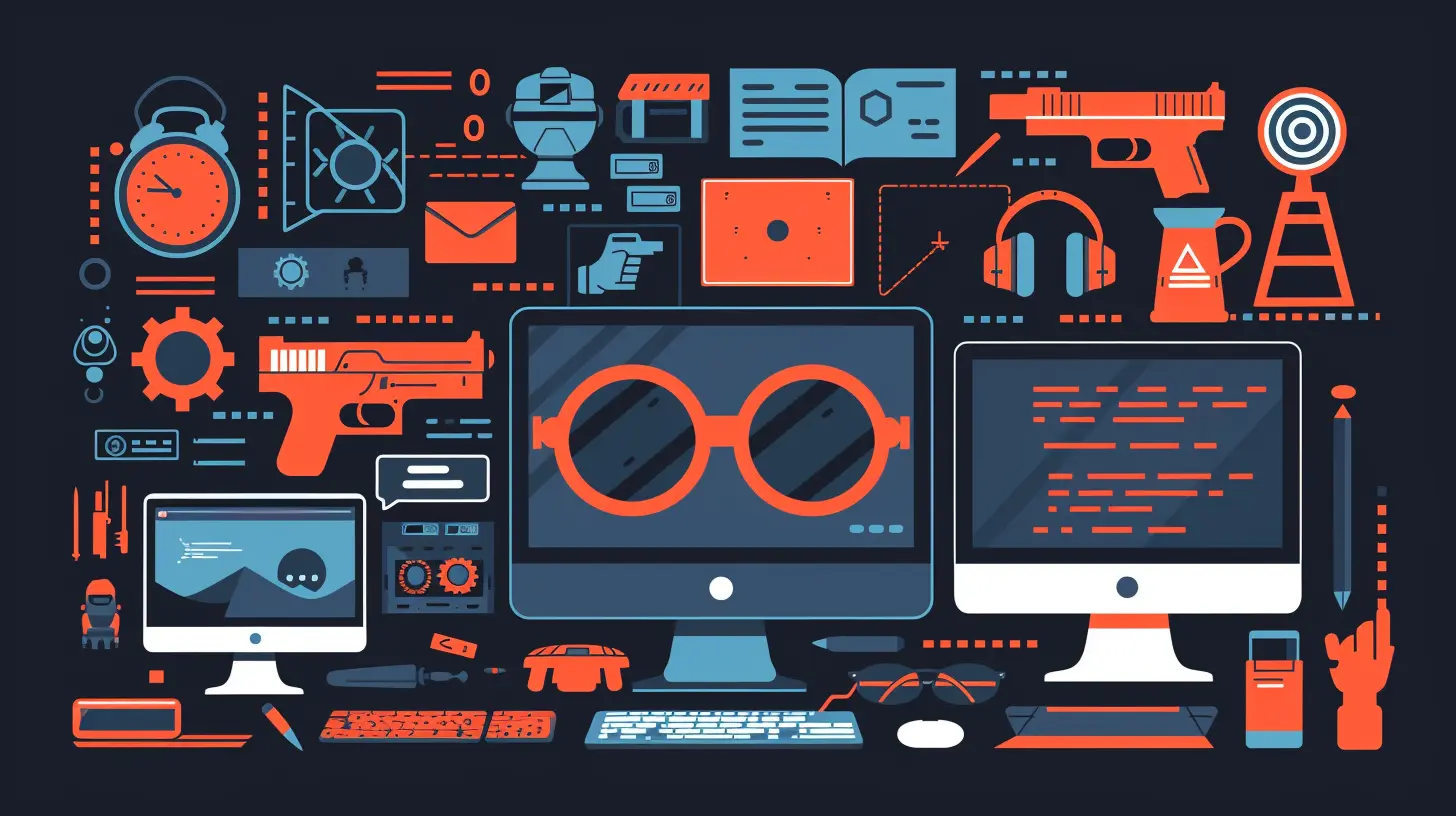Threat Hunting Explained: Proactively Defending Against Cyber Attacks
18 May 2025
In today's digital age, cyber threats are more sophisticated and aggressive than ever before. It’s like living in a bustling city where, behind every corner, there could be someone plotting a robbery. Now, would you just wait for the thief to barge in, or would you start bolstering your defenses ahead of time? That’s exactly where threat hunting comes into play in the cyber world. Instead of waiting for a breach to happen, threat hunting is all about proactively searching for potential threats before they can cause harm.
But hey, let's not get ahead of ourselves. In this guide, we'll break down everything you need to know about threat hunting, why it's vital for your cybersecurity strategy, and how it works in practice. So, grab your cup of coffee, and let's dive right in!

What is Threat Hunting?
At its core, threat hunting is a way of proactively searching for cyber threats that could be lurking within your organization’s network. Think of it as a cybersecurity detective going on the offense instead of waiting for an alarm to go off.Unlike traditional defense mechanisms such as firewalls or antivirus software, which rely on pre-set rules or signatures, threat hunting involves actively seeking out unknown or hidden threats. It’s not passive. It’s like patrolling the neighborhood instead of just locking the doors. Threat hunters are constantly looking for unusual behaviors, anomalies, or patterns that might indicate a potential attack.
Why is Threat Hunting Important?
In the world of cybersecurity, the stakes are high. A single data breach can cost a company millions, not to mention damage its reputation. What’s worse? The attackers are always evolving. They’re like shape-shifters, constantly changing tactics to evade detection.Traditional security measures are great for catching known threats, but what about the unknown ones? That’s where the magic of threat hunting comes into play. By being proactive, you can catch threats before they spiral out of control. In fact, many cyber-attacks go unnoticed for weeks or even months! Threat hunting can drastically reduce the time it takes to detect and respond to these hidden threats, minimizing the damage.

How Does Threat Hunting Work?
So, how exactly does this "cyber detective" work? Well, threat hunting is usually a multi-stage process. Let’s break it down:1. Hypothesis Creation
Every good investigation starts with a theory, right? In threat hunting, this is the hypothesis stage. Threat hunters develop hypotheses based on intelligence reports, past incidents, or even gut feelings about what might be happening within the network.Imagine you’re a detective. You've noticed footprints near a window that shouldn’t be there. You form a hypothesis that someone might have attempted a break-in. In the same way, a threat hunter might notice abnormal login patterns and hypothesize that an attacker is trying to gain unauthorized access.
2. Data Collection and Analysis
Once the hypothesis is formed, the next step is gathering data. Threat hunters collect logs, network traffic, and endpoint activity to validate their hypothesis. This step is like gathering evidence at a crime scene.Let’s say your hypothesis is that someone is trying to exfiltrate data. You’d collect logs from your network and endpoints to check for unusual file transfers or communication with strange external IP addresses.
3. Pattern Recognition
As the data rolls in, threat hunters look for patterns or anomalies. It’s like looking for the missing puzzle pieces. For instance, if you notice that a particular user account is logging in from multiple different locations in a short period, it might be a sign of something fishy, like credential theft or account compromise.4. Investigation and Response
If the threat hunter finds something suspicious, it moves into the investigation phase. The goal? To identify whether it’s a false positive or a real threat. If it's indeed a threat, the hunter will work with the incident response team to neutralize it. This could involve anything from isolating infected systems to blocking malicious IPs or resetting compromised credentials.5. Continuous Improvement
The final step is to learn from the hunt. What worked? What didn’t? Were there any gaps in your security that need to be addressed? Threat hunters work with security teams to ensure that defenses are strengthened and that future hunts can be even more effective.
Types of Threat Hunting
Just like there are different types of detectives, there are also various types of threat hunting. Here are the three main approaches:1. Structured Threat Hunting
This type of hunting is based on known attack techniques or frameworks like the MITRE ATT&CK. It’s like following the blueprint of a criminal’s past crimes. You already have a decent idea of what the attackers are going to do, and you hunt specifically for those known tactics and techniques.2. Unstructured Threat Hunting
In this approach, you don’t have a specific blueprint to follow. It’s all about looking for anything unusual or suspicious in your environment. Think of it as going on a patrol without knowing exactly what you’re looking for, but you’re alert for anything out of the ordinary.3. Situational or Data-Driven Threat Hunting
This is a mix of structured and unstructured hunting but is usually kicked off by a specific event or situation. For example, if there’s a new vulnerability making headlines, you might start hunting for signs that attackers are exploiting that vulnerability in your network.
Tools and Techniques for Effective Threat Hunting
Threat hunters don’t just rely on their instincts. They have a suite of fancy tools and techniques at their disposal to make the job easier. Here are some of the most common ones:1. SIEM (Security Information and Event Management) Systems
SIEM tools are the bread and butter for threat hunters. They collect and analyze data from various sources, such as network devices, servers, and applications. SIEM systems help hunters identify patterns, correlate events, and detect anomalies.2. EDR (Endpoint Detection and Response) Solutions
While SIEM tools focus on network data, EDR solutions focus on endpoints like computers, smartphones, and servers. EDR tools monitor endpoint activity for signs of malicious behavior and give threat hunters a detailed view of what's happening on the ground.3. Threat Intelligence Platforms
These platforms provide information about emerging threats, attack methods, and malicious actors. Think of them as the detective’s informants, providing valuable insights into the latest tricks attackers are using.4. Behavioral Analytics
Instead of just looking for specific patterns, behavioral analytics tools focus on understanding what’s "normal" behavior for your network and users. When something deviates from that baseline, it raises a red flag, and the threat hunter can investigate further.5. Machine Learning and AI
No, we're not talking about Skynet here, but machine learning and artificial intelligence can help threat hunters by automating certain tasks, like identifying patterns or anomalies in massive datasets. This allows hunters to focus on more complex investigations.Key Skills of a Successful Threat Hunter
Not everyone can be a cyber detective. It takes a unique blend of skills to be an effective threat hunter. Here are some of the key traits you’d need:1. Analytical Thinking
Threat hunting is like solving a mystery. You need to be able to analyze data, spot patterns, and piece together the puzzle.2. Attention to Detail
In this role, even the tiniest clue can lead to the discovery of a massive threat. Hunters need to be meticulous and detail-oriented.3. Knowledge of Attack Techniques
You can’t hunt what you don’t understand. A good threat hunter is always up-to-date on the latest attack techniques, vulnerabilities, and exploits.4. Curiosity
Sometimes, threat hunting requires following your gut instincts. The best hunters are naturally curious and always eager to dig deeper.5. Communication Skills
Once a threat is detected, the hunter needs to be able to communicate the findings to other teams, such as the incident response team. Clear communication is crucial for ensuring a quick and effective response.
Threat Hunting vs. Incident Response
You might be wondering: how is threat hunting different from incident response? The two are closely related but serve different purposes.Think of incident response as reacting to a crime after it’s already happened. The focus is on containing and mitigating the damage. On the other hand, threat hunting is about preventing that crime from happening in the first place. It's proactive rather than reactive.
While both are essential components of a strong cybersecurity posture, threat hunting aims to reduce the number of incidents that require a response in the first place.
Conclusion: The Importance of Being Proactive
In the ongoing battle against cyber threats, threat hunting represents a crucial shift in how organizations approach their security. Rather than simply reacting to attacks after they happen, threat hunting allows you to take the offensive, seeking out threats before they can cause harm.It’s not just about technology—though the right tools are essential. It’s also about mindset. Threat hunters are like skilled detectives, constantly on the lookout for clues, anomalies, and patterns that could signify something is amiss. And in today’s world, where attackers are more sophisticated than ever, that proactive mindset can make all the difference.
So, if your organization hasn’t yet embraced threat hunting, now’s the time to start. After all, the best defense is a good offense!
all images in this post were generated using AI tools
Category:
CybersecurityAuthor:

Michael Robinson
Discussion
rate this article
4 comments
Mara Perry
Threat hunting: it’s like hide-and-seek, but with cybercriminals and way less fun! Instead of counting to 100, we’re counting vulnerabilities. Remember, if you find a hacker hiding under your IP, it’s time to call in the digital SWAT team! 🚀🔍
May 30, 2025 at 4:52 AM

Michael Robinson
Absolutely! Threat hunting is crucial for staying ahead of cybercriminals by identifying vulnerabilities before they can be exploited. Your analogy perfectly captures the serious nature of this proactive defense. 🚀🔍
Veda McElveen
In shadows where the data flows, A dance of vigilance unfolds. With keenest eyes, the hunters roam, Protecting realms that call us home. From lurking threats, they weave a shield, In cyberspace, their fate revealed. Through proactive grace, our peace they tend, In code and courage, we defend.
May 29, 2025 at 11:56 AM

Michael Robinson
Thank you for your poetic insight! Your words beautifully capture the essence of threat hunting and its crucial role in safeguarding our digital realms.
Rachael Bowers
Great article! I appreciate how you break down the complexities of threat hunting. Proactive defense is essential in today’s digital landscape, and your insights provide valuable information for both beginners and experienced professionals alike.
May 23, 2025 at 3:33 AM

Michael Robinson
Thank you for your kind words! I'm glad you found the article helpful in understanding threat hunting and proactive defense.
Elara Hunter
Great overview of threat hunting! It's essential for organizations to adopt a proactive stance against cyber attacks. Understanding the techniques and tools involved can significantly enhance overall security posture.
May 20, 2025 at 3:32 PM

Michael Robinson
Thank you for your feedback! I completely agree—proactive threat hunting is vital for strengthening an organization's cybersecurity defenses.



